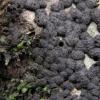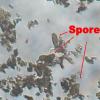
04-01-2026 17:45
 Stephen Martin Mifsud
Stephen Martin Mifsud
I was happy to find these orange asmocyetes which

03-01-2026 13:08
Niek SchrierHi all,We found groups of perithecia on a Lecanora

29-12-2025 17:44
Isabelle CharissouBonjour,J'aimerais savoir si d'autres personnes au

02-01-2026 17:43
MARICEL PATINOHi there, although I couldn't see the fruitbody, I

01-01-2026 18:35
Original loamy soil aside a artificial lake.The co

31-12-2025 19:27
Collected from loamy soil, at waterside (completel
Hypoxylon multiforme?
VASILEIOS KAOUNAS,
19-09-2008 07:22
Spores 10,2-11,6*4,2-5,2 ìm, Q=2,2-2,6
Christian Lechat,
19-09-2008 08:33

Re:Hypoxylon multiforme?
Difficult to say with so few elements, but it looks like H. cohaerens.
Regards,
Regards,
Jacques Fournier,
19-09-2008 08:48

Re:Hypoxylon multiforme?
Hi Vasileios,
H. cohaerens is specific for Fagus. Otherwise its main difference with H multiforme is the germ slit length on ascospores: short in multiforme, spore-length in cohaerens, best seen in KOH.
You can visit http://pyrenomycetes.free.fr/ for more informations.
Best wishes,
Jacques
H. cohaerens is specific for Fagus. Otherwise its main difference with H multiforme is the germ slit length on ascospores: short in multiforme, spore-length in cohaerens, best seen in KOH.
You can visit http://pyrenomycetes.free.fr/ for more informations.
Best wishes,
Jacques
VASILEIOS KAOUNAS,
19-09-2008 08:52
Re:Hypoxylon multiforme?
Thank you very much for your correspondence
Andrew N. Miller,
19-09-2008 18:08

Re:Hypoxylon multiforme?
I believe both H. multiforme and H. cohaerens (along with H. truncatum and H. annulatum) have all been transferred to the new genus, Annulohypoxylon by Y.-M. Ju, J.D. Rogers & H.-
M. Hsieh.
Andy
M. Hsieh.
Andy
Jacques Fournier,
19-09-2008 18:48

Re:Hypoxylon multiforme?
Hi Andy,
you are perfectly right as to the new name Annulohypoxylon but I told Vasileios to visit my website, which has not been updated since this change....names change but fortunately fungi do not much ..
Jacques
you are perfectly right as to the new name Annulohypoxylon but I told Vasileios to visit my website, which has not been updated since this change....names change but fortunately fungi do not much ..
Jacques




